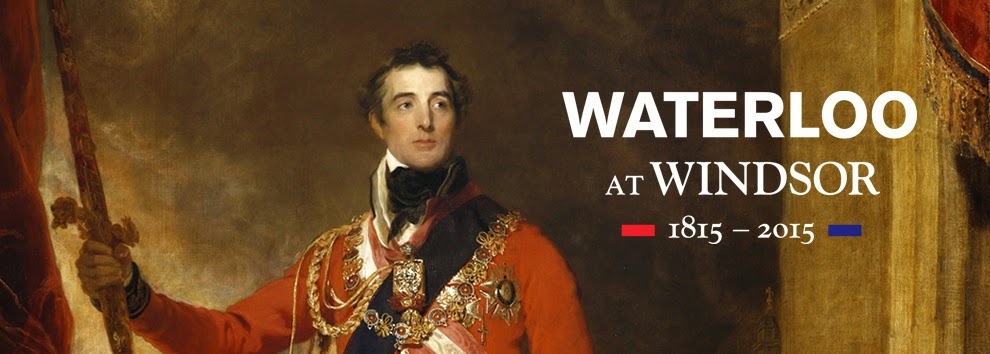By Guest Blogger Nicola Cornick
There can be few places more appropriate than Windsor Castle to hold an exhibition to commemorate the 200thanniversary of the Battle of Waterloo. Originally founded by William the Conqueror at the end of the 11th century, Windsor has been home to 39 monarchs and is the oldest royal residence in the British Isles. At various points in its history it has undergone major remodelling and one of these took place in the late 18th and early 19th century with the creation of a new grand staircase and state apartments. During the Peninsular Wars when there was a threat to the country from republican France, Windsor was recognised as a symbolic bastion of the British nation and the monarchy.
It was George IV who created the Waterloo Chamber in celebration of the allied victory of 1815, and the room was completed by his successor William IV. It is a vast pace filled with Sir Thomas Lawrence’s imposing portraits of those who were instrumental in the victory, including the Duke of Wellington. A portrait of George himself is placed at the centre of the room and thus as the focal point of the victory.
The “Waterloo at Windsor” exhibition is running throughout this year and I was lucky enough to go and see it a couple of weeks ago. It’s a fascinating mixture of prints, drawings and archive material from the Royal Collection, which explore the battle and its aftermath. The introduction to the exhibition is via the Drawings Gallery where there is a display of maps of the battlefield and paintings that were in some cases produced in the immediate aftermath of the battle, showing tourists already visiting the site. I also loved the collection of Rowlandson cartoons depicting Napoleon as a Corsican bloodhound and it was interesting to see some French propaganda cartoons and pictures, showing him from a very different perspective, that of the peacemaker of Europe. I also learned some fascinating facts; that amongst the memorials planned after the battle was one for a pyramid as high as St Paul’s Cathedral, which would have cost a million pounds in the currency of the day. Like many of the proposed memorials it was never built.
Elsewhere in the staterooms are a whole host of artefacts with connections to the battle. By far my favourite was Napoleon’s burnous, a red felt hooded cloak lined with yellow silk brocade and decorated with silver braid (above). This had been found amongst Napoleon’s baggage train on the field at Waterloo and was presented to the Prince Regent by General Blucher. Also taken from Napoleon’s belongings was a leather travelling desk, decorated with gold bees and the monogram “N.” It contained two inkpots, a sandbox, a candlestick and bell. Napoleon certainly didn’t travel light!
It was the little details of the exhibition that I enjoyed the most: The drawing of the Waterloo Elm, which had been Wellington’s command post during the battle, and the story that it was subsequently stripped of its leaves and branches by souvenir hunters and turned into a chair! The gorgeous silver gilt tea service and toast racks that Napoleon gave to his adopted daughter Stephanie on her marriage… Each item had a different story to tell and a different light to shed not only the Battle of Waterloo itself but also on the enigmatic Emperor who continued to be a figure of fascination even in exile.
Throughout 2015, Waterloo at Windsor: 1815–2015 will combine a themed trail through the State Apartments with a display of prints, drawings and archival material that explores the battle and its aftermath.
The trail will highlight objects seized on the battlefield by the victors, including silver, furniture, weapons and the beautiful red cloak belonging to Napoleon, presented to George IV by Wellington’s ally, Field-Marshal Gebhardt von Blücher.
You can visit guest blogger and USA Today Best Selling Author Nicola Cornick’s website here.




I love that burnous! Contemporaneous accounts of Napoleon from the other side would also be interesting, particularly any which were clearly free of censorship or influence.
Wonderful post, Nicola. How I wish I could visit the exhibit!